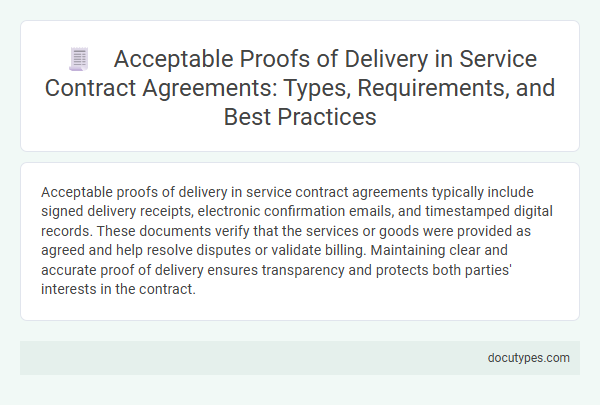Acceptable proofs of delivery in service contract agreements typically include signed delivery receipts, electronic confirmation emails, and timestamped digital records. These documents verify that the services or goods were provided as agreed and help resolve disputes or validate billing. Maintaining clear and accurate proof of delivery ensures transparency and protects both parties' interests in the contract.
Introduction to Proof of Delivery in Service Contracts
Proof of delivery in service contract agreements verifies that the agreed-upon services have been completed as specified. It establishes accountability and ensures both parties fulfill their contractual obligations.
You must provide acceptable documentation to confirm service completion, protecting your interests and avoiding disputes. Common proofs include signed delivery receipts, service completion reports, and digital confirmations.
Importance of Proof of Delivery for Contractual Compliance
Proof of delivery (POD) serves as critical evidence in service contract agreements, verifying that services or goods were received as specified. This documentation helps ensure contractual compliance and protects all parties from disputes.
- Verification of Service Completion - POD confirms that the service or product has been delivered according to the agreed terms, preventing misunderstandings.
- Legal Evidence - Acceptable proofs such as signed delivery receipts or electronic confirmation provide legally binding evidence in case of contractual disputes.
- Performance Tracking - You can use POD records to monitor service performance and maintain accountability throughout the contract duration.
Common Types of Proof of Delivery Documents
Acceptable proofs of delivery in service contract agreements ensure that services or goods have been properly delivered and received. Your service agreements typically specify the types of documentation required to verify this completion.
- Signed Delivery Receipts - Documents signed by the recipient confirming receipt of services or goods at the agreed location.
- Electronic Proof of Delivery (ePOD) - Digital confirmations such as scanned signatures or GPS-enabled delivery tracking data.
- Completion Certificates - Formal statements issued by a service provider verifying that the contracted service has been performed to satisfaction.
Digital vs. Physical Proofs of Delivery
Acceptable proofs of delivery in service contract agreements include both digital and physical forms that verify the completion and receipt of services. Digital proofs, such as electronic signatures, delivery confirmation emails, and timestamped digital receipts, offer efficient, easily stored verification methods. Physical proofs like signed delivery notes, paper receipts, or stamped documents remain valid, especially in industries or regions where digital acceptance is limited or legally restricted.
Legal Requirements for Valid Proof of Delivery
What are the legal requirements for valid proof of delivery in service contract agreements? Valid proof of delivery must unequivocally demonstrate that the service or goods were received as agreed. You should ensure documents like signed delivery receipts, electronic confirmations, or notarized statements comply with contract terms and relevant laws.
Elements of an Effective Proof of Delivery
Acceptable proofs of delivery in service contract agreements include signed delivery receipts, delivery confirmation emails, and timestamped photographs. An effective proof of delivery must clearly identify the service provided, include the recipient's signature or acknowledgement, and provide an accurate date and time stamp. These elements ensure accountability, verify service completion, and support dispute resolution in contractual obligations.
Best Practices for Collecting Proof of Delivery
| Acceptable Proofs of Delivery | Signed delivery receipts, electronic signatures, delivery confirmation emails, photographic evidence of delivered items, GPS tracking records, and timestamped delivery logs serve as reliable proofs in service contract agreements. |
|---|---|
| Importance of Proof of Delivery | Proof of delivery verifies that services or goods have been received as per contractual terms, reducing disputes and ensuring accountability. It protects both service providers and clients by confirming the completion of obligations. |
| Best Practices for Collecting Proof of Delivery |
|
| Conclusion | You benefit from establishing robust methods for collecting proof of delivery, which uphold service contract integrity and reduce potential conflicts. |
Risks of Inadequate Proof of Delivery
Acceptable proofs of delivery in service contract agreements include signed delivery receipts, electronic confirmation, and timestamped photographs. These documents validate the completion of service obligations and protect all parties involved.
- Legal disputes - Inadequate proof can lead to challenges in enforcing contract terms and resolving conflicts.
- Payment delays - Without proper documentation, payment processes may be halted or disputed, affecting cash flow.
- Service liability - Lack of evidence may increase the risk of liability claims due to unverified service completion.
Your contract's security depends significantly on the clarity and reliability of the proof of delivery.
Dispute Resolution and Proof of Delivery
Proofs of delivery in service contract agreements serve as crucial evidence to verify that services or goods were received as agreed. Acceptable proofs often include signed delivery receipts, electronic confirmation, and timestamped photographs.
In dispute resolution, these proofs help establish the fulfillment of contractual obligations and prevent conflicts. Your service contract should clearly define what constitutes acceptable proof to avoid ambiguity. Using detailed and verifiable delivery records strengthens your position if disagreements arise.
What Are Acceptable Proofs of Delivery in Service Contract Agreements? Infographic

